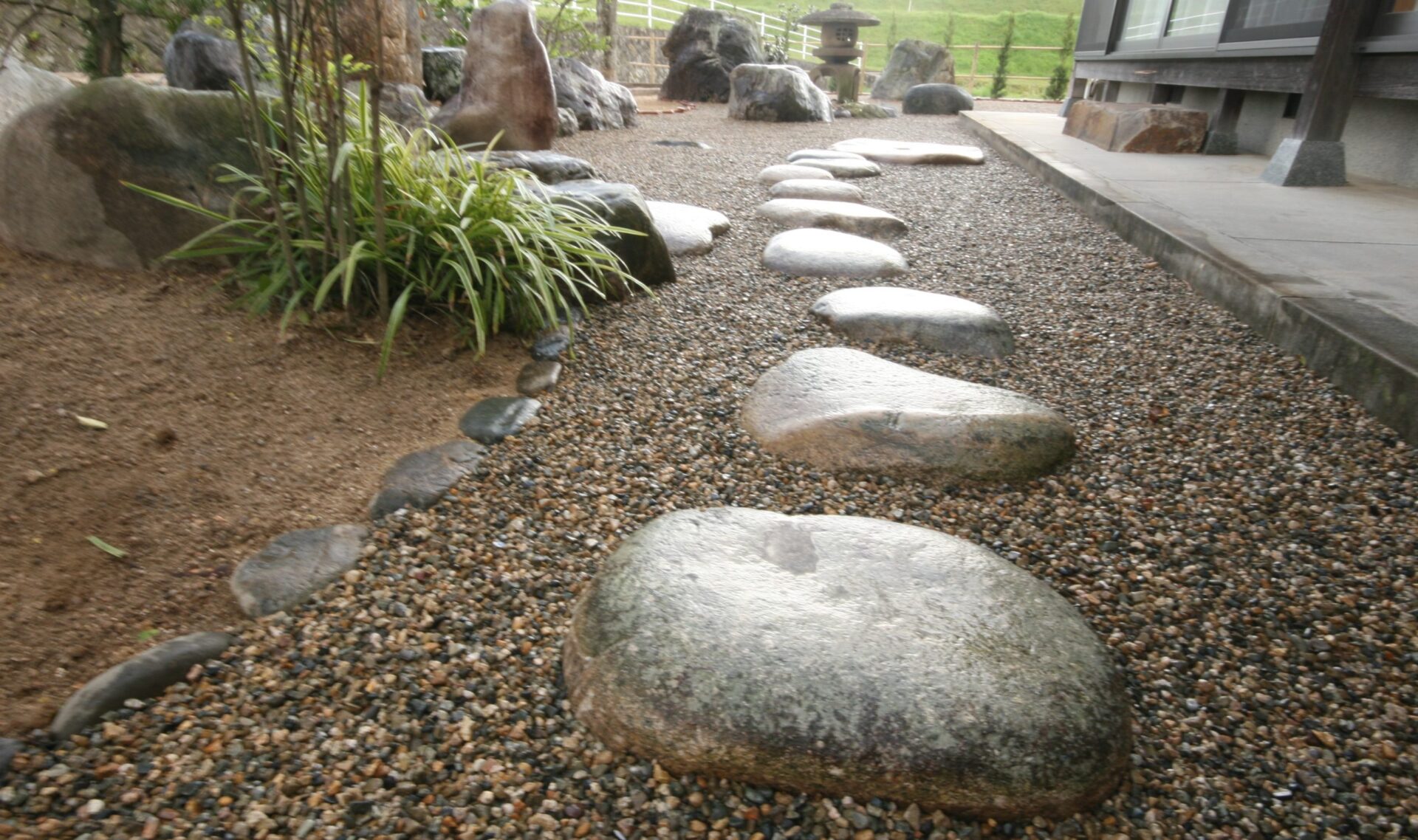島根県の出雲地方で、独特の発展を遂げたに日本庭園が出雲流庭園と呼ばれています。その出雲流庭園の特徴はどんなところにあるでしょうか。今回は飛び石の特徴についてみていきましょう。
なお、出雲流庭園は時代の流れにより、江戸時代、明治時代、昭和時代の3つの時代により変化をしています。今回の飛石の特徴については、3つの時代を通してみていきます。
飛び石はなんのため?
そもそも、飛び石はなんのためにあるのでしょうか。当然、飛び石の上を歩くためにあるというのは想像がつくと思います。確かに飛石の上を歩けば、砂利に足跡を残すこともなく、コケや植物を傷めることもなさそうです。飛び石も歩きやすいような幅や位置を工夫して設置されています。
では、飛び石を歩いてどこに行くのでしょうか。例えば庭の散策のために、飛び石があるのかもしれません。日本庭園には池の周りをぐるっと回って散策することができる庭園が多くあります。その場合だと、散策のために飛び石が置かれています。
出雲流庭園ではどうでしょうか。明治時代に造られた豪農屋敷の出雲流庭園では、飛び石を渡ってぐるっと一周できるところもあります。例えば、出雲文化伝承館の出雲流庭園などがそうです。
しかし、よく観察すると、飛び石は必ず寄り道をしています。つまり、飛び石を渡っていくと、用事のある所へ行きつくようになっています。
昭和時代に2000も3000もの数が造られた民家の出雲流庭園でも、同様に飛び石が用事のある所に向かっています。用事のある所とは、座敷の縁側、灯ろう、つくばい、中門です。座敷の縁側は、座敷への出入りができるようにしてあります。灯ろうには火を灯すことができるようにしてあります。つくばいは、手を洗えるようにしてあります。中門は外から座敷へとつながっています。
もちろん、実際に灯ろうに火を灯したり、つくばいで手を洗わなくても、飛び石を見ていれば、その用事ができるように、それらを繋げていることがわかります。
つまり、飛び石は、単に歩くためだけでなく、庭の施設の用事ができるようにしてあるのです。
そして、それが、実際に使うというよりも、飛び石をみれば情景が目に浮かぶように配置されていて、庭園にストーリーを持たせているのですね。

高く据えられている飛び石
出雲流庭園の飛び石は、通常よりも石の高さが高くしてあるのが特徴の一つです。通常とは、京都などにみられる飛び石のことです。
日本庭園、とくに露地といわれる茶庭では、侘び寂びの精神から、目立たず質素に造ると聞いたことがある方もいるでしょう。それゆえ、飛び石も地面すれすれまで下げることで、侘び寂び感を出します。
逆に、飛び石を高く据えると、派手に見えます。飛び石が立派に見えるのです。
では、なぜ出雲流庭園の飛び石は高く据えるのでしょうか。それは、江戸時代に松江城主が出雲大社へお参りになる際にお宿としていた、いわゆる御本陣のおもてなしと言われています。つまり、冬期に雪が多少積もっても飛び石は歩けて、茶事ができるようにしたという話が伝わっています。

飛び石に混ざる石臼
飛び石の中に、必ずではないですが、かなりの確率で飛び石以外のものが入っていることに気づきます。
それは、石臼です。見ると簡単に見つけられます。場所は中央に近いところに使われています。
これは、他の地方にも見られるので、出雲流庭園だけの特徴ではありませんが、出雲流庭園には非常の多いことで特徴の一つに挙げられます。
その理由は、水田で栄えた出雲地方は、石臼はきっと毎日利用する身近な道具だったのでしょう。豪農屋敷となれば、たくさんの石臼を使っていたと思われます。自然川石の中に、人工的に造った綺麗な丸型の石臼があれば、意匠的にも目を引きます。飛び石にも変化があり、デザイン的に美しいでしょう。
また、石臼は商売道具でもあります。日本庭園は縁起を担ぐものであることから、商売のますますの繁盛を願ったのかもしれません。
これについては、明確な理由はいまだ研究途中です。しかし、特徴としては非常に興味深いですね。

飛び石の中で異常に大きな石の正体
飛び石は、大体同じくらいの石が並んでいるから歩きやすいものです。しかし、出雲流庭園には、飛び石の中に、やたらと大きな石が入っています。
ちょっと大きな石ではなくて、やったらと大きな石です。通常の石の大きさが直径20㎝から30㎝の間だとすると、大きな石は1mも2mもあるような大きさです。
これは、飛び石の中でも、駕籠石とか駕籠台とよばれる石です。駕籠とはお殿様を載せた駕籠のことです。つまり、上述した御本陣にお殿様が到着の際、御成門から駕籠にのってはいれれ、駕籠石で駕籠を置き、降りてすぐに書院に入るわけです。
そこから、殿さまのいない現代においても、名残で駕籠石という、えらい大きな飛石が今も存在するのです。

飛び石のタブーは出雲には通用しない
飛び石は、庭師の世界ではいくつかの約束事があります。その一つが飛び石を十字になるように配置してはならないという教えがあります。
しかし、出雲流庭園はお構いなしで十字になるように配置がされています。しかし、単に十字になっているのではなく、石の大きさに変化をつけてうまく調和するように配置がされています。
なぜ、このようなことが起ったのでしょう。かつて京都を中心にして発展した日本庭園の技術は全国に広がっていきました。しかし、出雲地方にはその影響はあまりなく、逆に出雲地方独特の庭園技術が栄えていった証だと考えられます。

出雲流庭園の飛び石は、庭園の中でも広くとられた砂利の部分に沢山の飛び石が据えられていて、とても目立つ存在です。そして、独特の飛び石の打ち方が伝えられ、飛び石をみれば出雲流庭園であることがすぐにわかります。全国的にも飛び石の存在感をここまで高めた庭園は珍しいのではないでしょうか。それゆえ、飛び石の意味を知ることで奥の深い日本庭園の価値を知ることができます。出雲流庭園は出雲地方で発展した歴史文化を継承する財産というべき庭園なのです。


